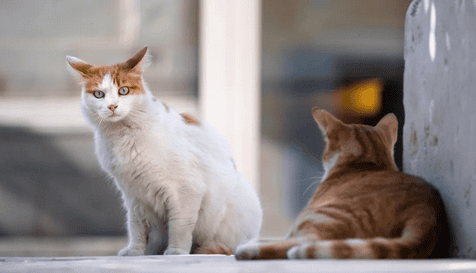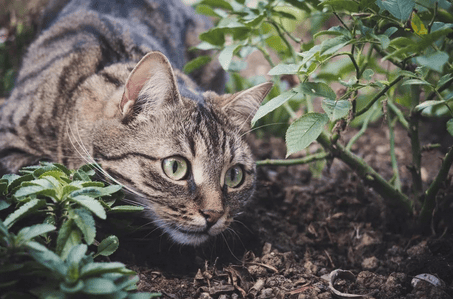1. Examination
Acute stress may cause tachycardia, tachypnea, hyperthermia and pupillary dilation in healthy cats.
Cats may hyperventilate, breathing rapidly and deeply, making it difficult to differentiate between heart or respiratory disease. In cats, 50% of heart murmurs are considered "harmless murmurs" and must be distinguished from murmurs secondary to physical disease. Acute stress may result in diarrhea or emptying of intestinal contents and/or anal glands during a visit or examination; some cats may also urinate. Blood and/or mucus on the surface of the stool indicates colitis, or possibly diarrhea. Cats can be very nervous when being palpated and it can be difficult to distinguish between pain and other physical ailments.

2. Diagnostic tests
Acute stress can cause temporary high blood pressure. This is common in stray cats. It is also common in cats who are in poor physical condition, socialized, or have had negative experiences early in life. Biochemical abnormalities secondary to acute stress include hyperglycemia and hypokalemia. Stress hyperglycemia is often associated with patients struggling with blood glucose levels that can reach as high as 1088mg/dl (60mmol/l) and remain elevated for up to 90-120 minutes, with or without glycosuria. Repeating the blood glucose test or performing a fructosamine test when the cat is calm can prevent misdiagnosis of diabetes.
Suffering-induced changes in the complete blood count (platelet hypersensitivity, neutrophilia, and lymphopenia) are also associated with epinephrine release. In conscious, healthy cats, restraint and blood collection may increase circulating red blood cells. Elevated urine pH may be due to respiratory alkalosis (hyperventilation).
Chronic Distress
For the causes of chronic distress, see the previous push (see the beginning of this push)
1. Behavioral Signs
The causes of chronic distress Behavioral signs may vary but often include chronic hiding behavior; living in only one location; hypervigilance; not participating in other activities with the family; not using the litter box but spraying urine elsewhere; fondness for scratching; changes in diet , including anorexia, overeating and vomiting; excessive grooming; irritability.
2. Establishing links with diseases
Stress-related diseases have now been discovered in many species, including humans. Examples include inflammatory bowel disease, respiratory distress and interstitial cystitis in humans, and respiratory disease in cattle. There is substantial evidence and growing awareness of the link between chronic distress and behavioral and physical health abnormalities in cats, and many feline organ systems are affected individually or simultaneously. The strong link between emotional and physical health emphasizes the need for behavioral assessment of the home and environment to identify stressors that may contribute to illness. In many diseases, a lack of behavioral history may result in an incorrect or incomplete diagnosis and treatment plan—as discussed below.
1. Feline idiopathic cystitis
There is a close connection between the troubles of feline idiopathic cystitis (FIC) and chronic cat diseases. FIC is the most common cause of lower urinary tract disease, with 55-73% of cats presenting with lower urinary tract symptoms having FIC. Symptoms include intermittent or chronic hematuria, stranguria, urinary tract infections, and possible urethral blockage.
FIC may cause complications. Recognized concurrent health problems include gastrointestinal symptoms, compromised immune system, and skin disease symptoms. Behavioral abnormalities associated with FIC include fear, nervousness, increased startle response, clinginess, withdrawal, aggression, and intermittent or persistent urination outside the litter box. Potential stressors in the social and physical environment need to be assessed to develop a treatment plan. Treatment includes analgesia, meeting the cat's environmental needs, and alleviating/eliminating major stressors.

2. Gastrointestinal diseases
Stressors can aggravate the relationship between intestinal Clinical signs associated with parasites such as Trichomonas fetus, Giardia, and Isospora. In asymptomatic cats with Trichomonas fetus infection, chronic distress can lead to increased parasite burden and diarrhea. Additionally, vomiting, diarrhea, stress colitis, and loss of appetite not related to parasitic disease may also be secondary to chronic distress in cats. A recent literature indicates that competition for food in multi-cat households is a stressor that often leads to abnormal behavior in cats.
Excessive grooming due to stress often causes hair balls to accumulate in the gastrointestinal tract. Although constipation is thought to be associated with chronic distress, such as in cats that cannot easily access the litter box, a recent study of shelter cats found no association between stressors and constipation.
Stress alters mucosal bacteria and intestinal barrier integrity, increases permeability and triggers local inflammatory responses. Environmental and social stressors such as other cats or pets in the home, moving, boarding, and being removed are more common in cats with inflammatory bowel disease.
3. Feline orofacial pain syndrome (FOPS)
FOPS is a neurological disease that causes severe oral pain. Toothache associated with eruption of permanent teeth and periodontal disease may trigger this condition, with cats scratching their mouths, especially their tongues, with their claws. Environmental factors may exacerbate the condition (e.g., social conflict between domestic cats), and cats with poor coping skills may be more vulnerable.
4. Immunosuppression and Infections
Immunosuppression and subsequent infections are also associated with chronic distress in felines, leading to new infections or recurrence of previous infections. These infections can be viral, bacterial or parasitic.
5. Obesity
Obesity is one of the most common diseases in cats and is a growing epidemic. In developed countries, up to 63% of pet cats are overweight or obese. Obesity is associated with metabolic and hormonal changes that predispose cats to other diseases, including diabetes, skin diseases, lower urinary tract disease, hepatic lipidosis (fatty liver disease), intestinal bacterial dysbiosis, tumors, and DJD (degenerative osteoarthropathy) , degenerative joint disease) and respiratory damage, as well as increased anesthesia and surgical risks.
There is evidence that obesity in dogs is associated with reduced quality of life and longevity; weight loss in overweight dogs is associated with increased energy, reduced emotional distress, and reduced osteoarthritis distress. It is generally believed that the same is true for cats.
While it may seem obvious that overeating behaviors contribute to obesity, there are other risk factors we can address to prevent and manage feline obesity and its consequences.
Neutering of both male and female cats is a predisposing factor. Failure to reduce calories by one-third after neutering can lead to obesity, which can affect cats of all ages, even kittens. Another cause of obesity is that owners don't notice that their cats are overweight or don't think it's a health problem. Owners often think that meowing means a cat wants food, but this is not the case.
Cats like to eat alone. During the food preparation and feeding process, multiple cats gathering together may cause trouble (how to eat, how much to eat, how to eat safely). Pain and depression can easily lead to overeating in people and cats too. When losing weight, changing your daily rations can also be stressful. Changes in food may cause cats to find that food is not reliably available and to consume food quickly when it seems safe.
Indoor cats that are moderately active or inactive are prone to obesity. Unfortunately, there are many reasons why indoor cats may be less active than outdoor cats—an inadequate environment, cat conflicts, or other causes of fear or anxiety. Feeding low-calorie foods, such as canned foods, 50% or more of the total diet and using foraging equipment, such as food mazes, can increase normal eating behaviors and help maintain and reduce weight.

 扫一扫微信交流
扫一扫微信交流
发布评论